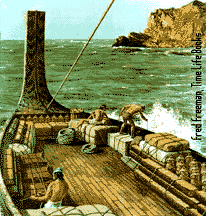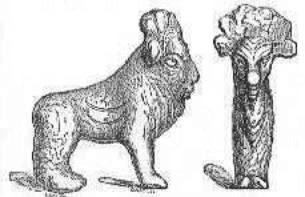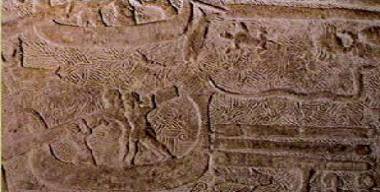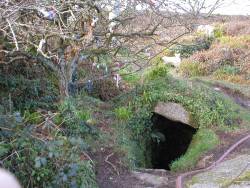
The Phoenicians in St Just

The coming of the Phoenicians
There are a number of legends about the Phoenicians trading with the Cornish for tin. One names the village of Treen not far from St Just as being at one time an important market town where the tin-streamers who worked the streams from Penwith would bring their tin and other goods to trade with the Tyrian merchants. It was these Tinners who constructed Castle Trereen as a place to protect themselves and their goods against attack.
The Legend.
One day a wise man named Picrous was walking on the sands when he decided to catch some fish, for a meal. Having set his line he gathered some drift wood and a few stones to make a fireplace. One of these stones was a large black one which he laid on the floor as the hearth. For some reason he had real problems cooking the fish he had caught and had to get the fire really hot. Suddenly a beautiful stream of white metal flowed out of the fire. The wise man thought that the gods had given him a gift which his tribe could use. However, he decided to check with the wise man of an adjoining tribe who was known for his magical powers. The two men strolled along the beach together picking up all the black stones. Once they had a large pile the second druid set to work and discovered that by breaking the stones into small pieces and then grinding these into a sand the metal was easier to extract. Once this had been accomplished the two men then tried taking the sand from the beach and heating this but it was a long time before Chywidden, (for that was the name of the second Druid), discovered the secrets which are used to day to separate the tin bearing sand from the rest.
At last, Chywidden found the answer and the men of the two tribes were called together and shown the metal and the method used to get it. Great was the joy and many days of feasting took place and the mead and other drinks flowed in abundance.
The party at last came to an end, and the tribes set to work and soon accumulated a vast quantity of this precious metal which they used to make decorative items and jewelry. These they traded with other tribes and slowly the items found their way to far distant lands and at a city called Tyre there lived a people who traveled the seas trading and who knew of the metal from other places. These people were known as the Phoenicians and they decided to find this place in the Western sea where there was said to be plentiful supplies.
The tinners feared that people would come looking for the source of their treasure so they built a series of castles or earth works where they could defend themselves and stop any strangers from landing. One of these was at Treneer on the coast between the beaches of Penberth and Porthcurnow and it was to this place that the Phoenicians first came. At first the tinners were suspicious but after a time it was agreed that the strangers could come to the beach to trade but no further. The Phoenicians then founded trading bases on off shore islands and these became known as the Cassiterides.

The Evidence
Many learned people will tell you that the Phoenician's never visited Cornwall. However if you visit the Egyptian Room in Truro Museum you will find in the bottom corner of a glass case a tiny bronze figure of a bull with a human face (shown above). The story of this find is interesting.
In his book entittled “Tin In Antiquity”. Mr R. D. Penhallurick 1. tells us that
" in January 1832, a workman by the name of John Lawry was demolishing a Cornish stone hedge whilst working in the Vicarage garden at St Just in Penwith, Cornwall. Having removed the hedge he started to dig a trench in order to do some planting. Suddenly he hit a series of large stones with his shovel and decided to take a closer look."
What
he had found was to lead to a controversy, which is still ongoing.
John Lawry had discovered the remains of an ancient building and as he worked
to uncover more he found evidence that the building had burned down and amongst
the ashes he found a small bronze statuette of a bull. He liked the look of the
bull and decided to keep it giving it pride of place
in his home."
The
story interested me and I decided to pay a visit to the Truro Museum where I was
informed that the bull was on display in the Egyptian section.
The
assistant librarian was a great help and found me the history file 2.
which contains all the correspondence about the bull. From this I learnt that
when John Lawry died his wife decided to sell the little bull to a James White
who was the collector of tithes for the parish and White told the vicar the
Rev.John Buller of his purchase.
Now it seems that The Rev. Buller had a number of friends who were involved in
Archaeology and he showed them the bull. And following inspection most decided
it was of Phoenician origin based mainly on the fact that they were supposed to
have worshipped the bull and some beads had recently been found near the Lands
End which were believed to be
Phoenician. Buller was skeptical
feeling that it was more likely to have been Greek. The argument raged backwards
and forwards within the Royal Cornwall Institute until in the end it was decided
to send the bull off to the British Museum where a Mr S Birch examined it and
decided that this was such a good find he would write a paper and present
it to the Archaeological Institute. He also had it published in the twenty-fifth
addition of that Institute's Journal.3.
In his paper, Birch stated that it was his belief that the bull was not of
Phoenician origin as the Phoenicians had comparatively speaking left no
ornamental remains behind them.
“Almost all their art monuments are of a period later than the seventh century before Christ”
and
on the basis of this argument he declared that the bull was from the Roman
period around the time of Hadrian.
Mr Birch had now made matters worse within the learned ranks in Cornwall. On
receiving Birch’s full report, Dr C Barham of the Royal Cornwall Institute
produced a paper which he presented to the Institute laying out the arguments
put forward by Birch.4.
In it he pointed out
“that the members of the Institution interest in this Cornish Antiquity must naturally be stronger than that of strangers to the county.”
and
proceeded to produce a series of counter arguments in favour of the Phoenician
connection.
One of the arguments put forward by Dr. Barham was as follows:-
“The fact that no object that can be satisfactorily identified with the
Phoneticians, having yet been found in Britain, and the legitimate doubts as to
the direct maritime commerce between Tyre and the coast of Cassiterides, would
create considerable caution in receiving a newly found monument as of Phoenician
origin. At the same time, certain peculiarities of type distinguish Asiatic
forms. arts and religions from the Greek, consisting in the union of human and
animal forms, and in the decoration of animal types, occur in the
Phoenician cultus, which seems to have been more allied to the Egyptian and
Assyrian idolatries than to the Hellenic." 5.
In the 1850’s little was known about the Phoenicians and the fact that both parties could be right was therefore not considered. Since ancient times there has been speculation as to the origins of the Phoenicians. The Greeks were particularly puzzled by them and gave them the name “Phoinikes” which loosely translated as “red people” some say from the colour of their land, whilst others argue it was the colour of their hair.6.
Does
this give a different slant to the tale told by William Bottrell in which
he states:
"If
old traditions may be relied on, the unseemly nickname Sennen B________s
originated in a remarkable way. They say that it was given long ago, owing to
the Danish blood inherited by a few families who lived on the shore of Whitesand
Bay.7.
Many Lands End folk have still a strong antipathy to what they regard as marks
of descent from northern pirates who ravaged the West more than a thousand years
ago. Here in old times Scandinavians generally seemed to have been called Danes;
and from prevalence in some families of this Parish, of the fiery-hued hair
ascribed to those northern marauders the inference is obvious, and the vulgar
nickname accounted for which was given in ages past and originated with kind and
discriminating neighbours." 8.
Maybe the red hair amongst the folks of Sennen comes from the Phoenicians instead of the Danes.
The
Phoenicians called themselves Canaanites, and modern researchers tell us they
were the descendents of two groups, the early Canaanites who inhabited the
shores of Lebanon and the Sea People who invaded the Lebanon about 1200B.C. It
is thought that the Sea People originated from an area on what we now call the
Gulf. 9.
Birch’s argument that little in the way of Phoenician artefacts had been
found was challenged in the 1920’s When the Rev Taylor who was now the vicar
of St Just in Penwith again wrote to the British Museum saying that he felt the
Bull probably belonged to a worshipper of Mithras who had made a temporary home
on the site of the vicarage whilst buying tin.10. The museum agreed
to once again inspect the bull and after consulting with Mr Hall of the
Egyptian Department a Mr Smith wrote to the Truro Museum on the 21st of March
1929 stating that in his opinion the bull was Egyptian of the Roman period.11.
Because of discoveries of the remains of a number of Phoenician cities in the
last hundred years this argument can be countered and that rather than
being firmly planted as one nation, the Phoenicians started in Lebanon, but
established colonies all along the coast of the Mediterranean. At the time of
Solomon 1000B.C. they occupied a number of these city-states at Byblos, Sidon,
Tyre, Berytus (Beirut), Tripoli, Baalbeck and Caesarea.12.
"Tarshish
was thy merchant by reason of the multitude of all kinds of riches; with silver,
iron, tin, and lead, they traded in thy fairs."13.
Tyre, was ruled over by King Huram whose people were not only skilled at moving things by sea but also had other skills. Solomon needed Cedar and other goods when he was constructing the Temple in Jerusalem and approached the Phoenician King about supplying them. Solomon asked the King
“Send me now therefore a man cunning to work in gold, and in silver, and in brass, and in iron, and in purple, and crimson and blue, and that can skill to grave with the cunning men that are with me in Judah and Jerusalem.14.
By this reference we now know that in the two hundred years since their arrival in Lebanon, the Phoenicians had developed as major traders and craftsmen at the centre of the ancient world. The Oxford Dictionary definition of Brass is a mixture of Copper and Tin or Zinc.
Copper was being produced in ancient Israel as early as 4200B.C.. Archeologist Tom Levy and his team discovered the village of Shipmim, in the 1970's. with remnants of copper smelting.15.
"TIN was known as an alloy with Copper at least as early as 1600 B.C. in Egypt, and probably before 2000 B.C. in Europe. It was also prepared pure in Egypt at least by 1400 B.C. The source of it is much debated. Banca, Spain, and Britain have all been proposed. That it appears as an alloy earlier in Europe than in Egypt shows that it was European. - - - The word used by Homer kassiterov, is the same as the Arabic kasdeer, probably derived from ancient Phoenician.16.
Certain
it is that these mariners brought Tin from the Cassiterides, which embraced the
Scilly Isles and the coast of Cornwall.17. One of the most
remarkable facts connected with the early races in Europe and Asia was the
extensive use of weapons and implements of Bronze; and the noted British
archeologist, Sir John Evans, shows that the use of Bronze preceded that of Iron
in Egypt ."
As more and more remains of these Phoenician cities have been discovered, the finds show that Phoenician art clearly reflected the influences of Egypt, Syria, and Greece. Phoenician deities were represented in Egyptian and Syrian attire and were surrounded with foreign symbolism adopted by Phoenician artists and used to illustrate indigenous beliefs. The Phoenicians excelled at metal craft and carving and this is why King Solomon made the request for Phoenician Artists to work on the Temple.19.
The Phoenician ivories and metal relief's were copied in many neighbouring regions, especially in Palestine, Greece, and Etruria. Their artisans settled in Egypt and Greece and imported Syrian work as well as their own, increasing the amalgamation of styles. The principal Phoenician excavations are at Byblos, but Phoenician works in jewellery, glass, clay, alabaster, ivory, many metals, faience, and wood are found in all Mediterranean countries and neighbouring areas of Asia Minor.20.
The
ancient world had much to thank Tyre for. The Greek attributed the introduction
of the alphabet to their country to Cadmus, the son of a Tyrian king. The name
of the continent is said to come from Europa, the sister of Cadmus. But it
was Tyre's purple-dyed textiles, worn throughout the ancient world as a
mark of royal rank, that brought fame and fortune to the city. One gram of pure
purple dye was worth ten or twenty grams of gold, so it is not surprising that
some of the beautiful sarcophagi of the necropolis belonged to wealthy purple
dye manufactures of Tyre. The ancient Tyrians extracted the dye from the Murex,
a marine snail that still lives along Tyre's shores deep among the rocks and
sunken archeological remains. Dye extraction is no longer a viable commercial
venture, but scientists have documented the process for historical purposes.21.
Later excavations were to uncover other city-states with royal tombs which had
only been partially looted. Amongst the finds was a wall plaque of
Phoenician ships.

It
comes from the palace of Sargon at Nineveh and shows a vessel loading timber,
presumably cedar, and is dated around 700 BC.22. The
timber cargo was partly stowed on deck and the rest was towed as a raft behind
the ship. Evidence for this practice comes from King Hiram’s reply to Solomon
about the supply for timber for his temple in Jerusalem: "My servants shall
bring them down to Lebanon unto the sea; and I will convey them by sea in floats
unto the place that thou shalt appoint me."23.
All this shows that the Phoenicians were artists and traders, but what of the St
Just Bull? Tin from mines in Cornwall
[England] came to the peoples of the Mediterranean, during the Homeric epic,
circa 950 to 900 B.C.24.
If you turn your attention again to the photo of the wall plaque above you will see on the left hand side that it shows a merman half human half fish, swimming between the bows of the ships. The Phoenicians primary god was El, protector of the universe , but often called Baal he is usually represented by a bull. However, a figure of a lion with a human face was found in a temple at Byblos and this is believed to represent Baal, the son / sun god who was primarily a fertility god and appears not only in this form but also in the form of a man and a bull (like his father 'El). Archaeologists have unearthed objects in Phoenicia and Canaan from the period of the Late Bronze Age (1540-1200 BCE) showing kings and rulers seated on thrones whose side arms consist of winged four-legged beasts, possessing a lion's body and a human head.25.
By stressing through these forms his potency and virility, Baal represents the masculine element, and serves as the fertilizing, life-giving, and life-renewing aspect through whom the Mother Goddess fulfills her functions, She was called Astarte / Asherar-yam, our lady of the sea, and in Byblos she was Baalat, our dear lady.26. Coins found at one of the ancient Phoenician sites have a Mermaid on them and it is believed that this is a representation of Astarte.
She was also linked with mother goddesses of neighbouring cultures, in her role as combined heavenly mother and earth mother. Cult statues of Baal and Astarte in many forms were left as votive offerings in shrines and sanctuaries as prayers for good harvest, for children, and for protection and tranquillity in the home and a number have been found showing the animal body and the human face. The Phoenician triad was incorporated in varying degrees by their neighbors and Baal and Astarte eventually took on the look of Greek deities.27.
 It
is my believe that the Phoenicians did indeed visit Cornwall and that they left
their gods and goddess behind when they left. A visit to Cornwalls ancient wells
at Sancreed, Madron and Alsia, near St Buryan will show that people still leave
offerings today in the hope that the ancient Gods will smile on them and
some of the legends have been passed down.
It
is my believe that the Phoenicians did indeed visit Cornwall and that they left
their gods and goddess behind when they left. A visit to Cornwalls ancient wells
at Sancreed, Madron and Alsia, near St Buryan will show that people still leave
offerings today in the hope that the ancient Gods will smile on them and
some of the legends have been passed down.
Sancreed Well
References.
“Tin in Antiquity” By R.D.Penhallurick, Institute of Metals, 1986.
File of documentation on the Bronze Bull. Courtney Library, Truro.
A Bronze Bull, found at St just in Penwith. Paper by S Birch Req. of the British Museum. Pub. Journal of the Archeological Society No. 25.
Abstract of Remarks by S Birch, Reg., of the British Museum, on a Bronze Bull found at St Just in Penwith, with some account of the intercourse of the Phoenicians with Cornwall, By Dr. C. Barharn, Sec. B.I.C. Pub. 7th November 1850 in the Journal of the Royal Cornwall Institute.
ibid. 4
Simon Hornblower and Antony Spawforth, eds. The Oxford Classical Dictionary. (Oxford 1996). ISBN 0-19-866172-X.
Stories & Folk-Lore of West Cornwall, 3rd Series. By William Bottrell. Pub 1880 by the Author. Facsimile reprint 1996 by Llanerch Publishers, Felinfach, Wales. ISBN 1 86143 003 5.
ibid.7.
“In Quest of a Mermaid” Author J.H.Williams published by Rupert Hart Davies 1960.
Letter from the Rev. Taylor to Mr S Birch. On file at the R.C.I. Truro.
Letter from Mr Smith of the British Museum dated 21st of March 1929. On file at the R.C.I. Truro.
Site on the WWW
"The Bible @ Ezekiel 27:12.
“The Bible @ 2nd Chronicles chapter 2.”
National Geographic April 1999.
Homer's, Iliad xviii. 474 and 613
Ancient Egyptians, Vol.3, Wilkinson,
Ancient Bronze Implements, Sir John Evans pp.7,8
ibid 14
The African Background to Medical Science: Essays on African History, Science and Civilizations. Finch, Charles S. III Preface by Ivan Van Sertima. London: Karnak House, 1990.
The History of Ships, Kemp, P., (London, 1978) pp: 20
?
"The Bible" 1st Kings, chapter 5, verse 9.
W. Dinan, M.A., mentions in his book: "Monumenta Historica Celtica"
Cherubim and Seraphim," under "Angel." Vol. 1, pp.131-132. T. H. Gaster. George A. Buttrick. Editor. The Interpreter's Dictionary of the Bible. Nashville. Abingdon Press. 1962. ISBN 0-687-19270-6. 4 Vols plus supplement.
The Myth of the Goddess: Evolution of an Image, Anne Baring and Jules Cashford,London: Penguin, 1993.
LINKS
For
a full examination of the question, Did the Phcenicians trade with Britain for
tin? the following works should be consulted :—“ History ot Maritime and
Inland Discovery,” by W. D. Cooley; “Historical Survey of the Astronomy of
the Ancients,” by Sir George Cornewall Lewis; “Commerce and Navigation of
the Ancients,” by W. Vincent, D.D.; “Phanicia,” by John Kenrick, M. A.;
“The Cassiterides: an Inquiry into the Commercial Operations of the
Plitenicians in Western Europe, with Particular Reference to the British Tin
Trade,” by George Smith, LLD., F.A.S.
![]()